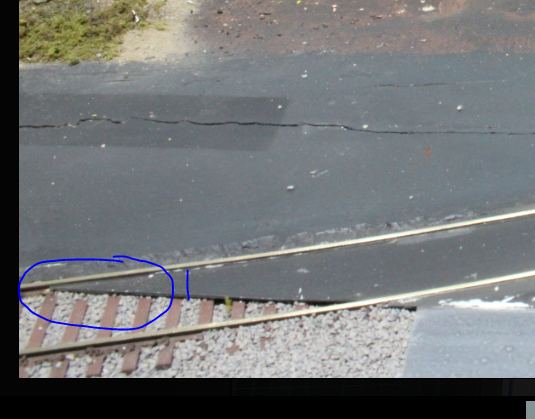Writing back and forth a couple of times with friend Sean Steele this week, he pointed out to me that the asphalt between the rails at one end of a level crossing on the layout didn't really look right, and could maybe be modeled a bit better. He sent along these two photos below to show me what he was referring to.
Also in the photo, I'm sure you can't help but notice the masking tape, which surrounds the area where the old Gulf station is being located. Gravel and ground cover, spread loosely in the photo, will be glued down and then the tape removed, which will hopefully leave a clean area for the station and lot to drop into place.
I know that's a way-too-big and obvious curb where the asphalt road meets the concrete. I'll try to fix that after I find my hydrocal. I've got some around here someplace.I found this video demonstrating how to create tracks in pavement, also known as street running interesting. The idea seems to be to basically make a styrene "tray" to fit in between the rails (allowing for flangeways inside each rail of course), and then fill the "tray" with "molding paste", whatever that is.
I would think that wall spackling should work as well. Anyway, the tray would be made of .020 styrene for the bottom, and styrene angle (Evergreen) for the sides and ends.
If I ever get caught up on my far-too-many other projects here, I think I just might have to experiment with this. Here's the link to the video...
Model Railroad Buried Track Final Tutorial | River Road - Vlog #72 - YouTube



Masking tape forms and tinted "setting type" drywall compound always worked well for me, 45 minute compound specifically. I carved straight edges and flangeways while it was damp but not completely dry, plus whatever tint you use (i.e. india ink) gives it color all the way through. Sometime crossings uses timbers to form flangeways too. There truly is no right or wrong way to *effectively* model roads and grade crossings!
ReplyDeleteThere's also a video on YouTube of some short line using a locomotive to cut flangeways in some hot, fresh asphalt
ReplyDeletehttps://youtu.be/EXt1ITqRazI
ReplyDeleteIts very unlikely that asphalt crews would lay it to a fine point like that, they typically make terminations squared off so the roller can properly compact it.
ReplyDeleteThanks Sean. It's a little thing, but if it makes it better, why not correct it. I'm doing a bit of other upgrading right in that area anyway, so it's a good time to fix that up too.
ReplyDelete